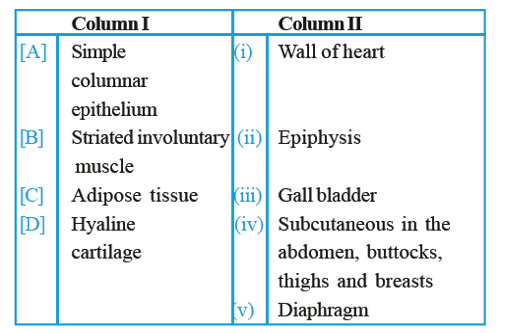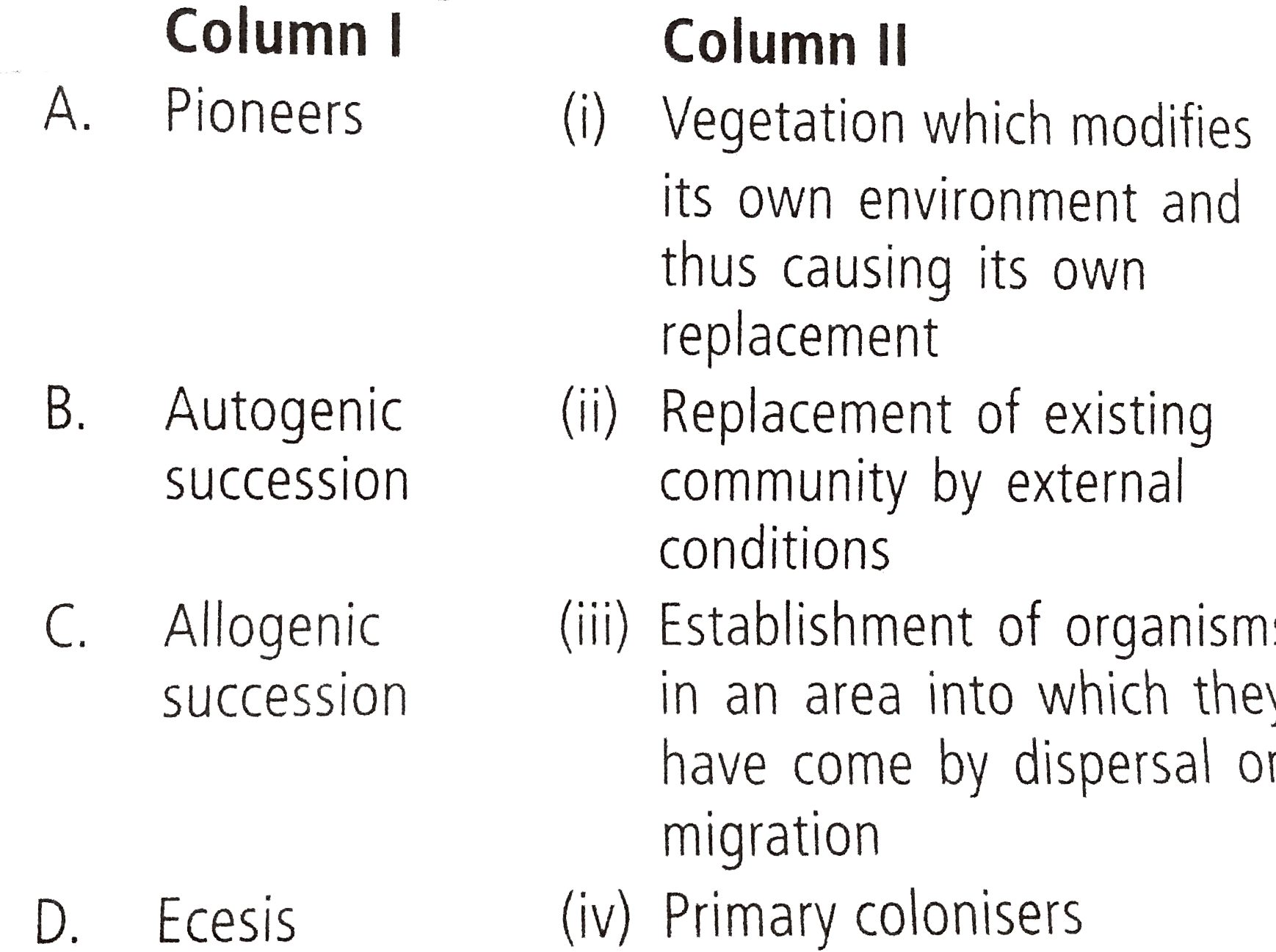Match column I with column II and select the correct option from the codes given below ltBrgt Column IColumn IIA. Uremia(i). Ketone bodies in urineB. Ketonuria(ii). Artificial kidneyC. Glycosuria(iii). Glucose in urineD. Blood dialyser(iv). Accumulation of urea in blood
A-(iii),B-(iv),C-(i),D-(ii)
A-(iv),B-(i),C-(iii),D-(ii)
A-(i),B-(iv),C-(ii),D-(iii)
A-(ii),B-(i),C-(iv),D-(iii)
The correct Answer is:B
To solve the matching question, we will analyze each term in Column I and find its corresponding term in Column II.
1. Identify Uremia:
- Uremia is a condition characterized by the accumulation of urea in the blood.
- Match: Uremia → (iv) Accumulation of urea in blood.
2. Identify Ketonuria:
- Ketonuria refers to the presence of ketone bodies in the urine, which can occur in conditions like diabetes.
- Match: Ketonuria → (i) Ketone bodies in urine.
3. Identify Glycosuria:
- Glycosuria is the condition where glucose is present in the urine, often associated with diabetes mellitus.
- Match: Glycosuria → (iii) Glucose in urine.
4. Identify Blood Dialyzer:
- A blood dialyzer is an artificial kidney used for filtering blood, especially in patients with kidney failure.
- Match: Blood dialyzer → (ii) Artificial kidney.
Final Matches:
- A (Uremia) → (iv) Accumulation of urea in blood
- B (Ketonuria) → (i) Ketone bodies in urine
- C (Glycosuria) → (iii) Glucose in urine
- D (Blood dialyzer) → (ii) Artificial kidney
Conclusion:
The correct matches are:
- A → iv
- B → i
- C → iii
- D → ii
Thus, the correct option is Option 2.
- Uremia is a condition characterized by the accumulation of urea in the blood.
- Match: Uremia → (iv) Accumulation of urea in blood.
- Ketonuria refers to the presence of ketone bodies in the urine, which can occur in conditions like diabetes.
- Match: Ketonuria → (i) Ketone bodies in urine.
- Glycosuria is the condition where glucose is present in the urine, often associated with diabetes mellitus.
- Match: Glycosuria → (iii) Glucose in urine.
- A blood dialyzer is an artificial kidney used for filtering blood, especially in patients with kidney failure.
- Match: Blood dialyzer → (ii) Artificial kidney.
- A (Uremia) → (iv) Accumulation of urea in blood
- B (Ketonuria) → (i) Ketone bodies in urine
- C (Glycosuria) → (iii) Glucose in urine
- D (Blood dialyzer) → (ii) Artificial kidney
The correct matches are:
- A → iv
- B → i
- C → iii
- D → ii
Topper's Solved these Questions
- EXCRETORY PRODUCTS AND THEIR ELIMINATIONBook:NCERT FINGERTPS ENGLISHChapter:EXCRETORY PRODUCTS AND THEIR ELIMINATIONExercise:Assertion & Reason
Explore 15 Videos
- EXCRETORY PRODUCTS AND THEIR ELIMINATIONBook:NCERT FINGERTPS ENGLISHChapter:EXCRETORY PRODUCTS AND THEIR ELIMINATIONExercise:Excretory Products And Their Elimination
Explore 133 Videos
- DIGESTION AND ABSORPTIONBook:NCERT FINGERTPS ENGLISHChapter:DIGESTION AND ABSORPTIONExercise:Digestion And Absorption
Explore 137 Videos
- LOCOMOTION AND MOVEMENTBook:NCERT FINGERTPS ENGLISHChapter:LOCOMOTION AND MOVEMENTExercise:Locomotion And Movement
Explore 139 Videos
Similar Questions
Match Column I with Column II and select correct option from the codes given below.

View SolutionMatch column I with Column II and select the correct option from the codes given below
Column IColumn IIA. Pteris(i). BryophyteB. Cedrus(ii). PteridophyteC. Sonchus(iii). GymnospermsD. Marchantia(iv). Angiosperm
View Solution
Knowledge Check
Match column I with II column II and select the correct option from the given codes .
 AA-(ii), B-(iii), C-(iv), D-(i)BA-(iii), B-(ii), C-(i), D-(iv)CA-(iii), B-(ii), C-(iv), D-(i)DA-(i), B-(ii), C-(iii), D-(iv)
AA-(ii), B-(iii), C-(iv), D-(i)BA-(iii), B-(ii), C-(i), D-(iv)CA-(iii), B-(ii), C-(iv), D-(i)DA-(i), B-(ii), C-(iii), D-(iv)Match column I and II and select the correct option from the given codes.
 AA-(iii),B-(iv),C-(i), D-(v), E-(ii)BA-(iii),B-(i),C-(iv), D-(v), E-(ii)CA-(iii),B-(iv),C-(v), D-(i), E-(ii)DA-(ii),B-(iv),C-(i), D-(v), E-(iii)
AA-(iii),B-(iv),C-(i), D-(v), E-(ii)BA-(iii),B-(i),C-(iv), D-(v), E-(ii)CA-(iii),B-(iv),C-(v), D-(i), E-(ii)DA-(ii),B-(iv),C-(i), D-(v), E-(iii)Mathc column I with column II and select the correct option from the given codes.
 AA-(ii), B-(iii), C-(iv), D-(i), E-(v)BA-(v), B-(iv), C-(iii), D-(i), E-(ii)CA-(i), B-(iii), C-(iv), D-(ii), E-(v)DA-(i), B-(iv), C-(iii), D-(ii), E-(v)
AA-(ii), B-(iii), C-(iv), D-(i), E-(v)BA-(v), B-(iv), C-(iii), D-(i), E-(ii)CA-(i), B-(iii), C-(iv), D-(ii), E-(v)DA-(i), B-(iv), C-(iii), D-(ii), E-(v)
Match column I with column II and select the correct option from the codes given below
Column IColumn IIA. Psilopsida(i). PsilotumB. Lycopsida(ii). EquisetumC. Sphenopsida(iii). SelaginellaD. Pteropsida(iv). Dryopteris
View SolutionMath column I with column II and select the correct option from the codes given below
Column IColumn IIA. Food(i). Brown algaeB. Agar(ii). Porphyra, LaminariaC.Algin(iii). Gelidium, GracilariaD. Carrageenin(iv). Red algae
View SolutionMathc column I with column II and select the correct option from the given codes.

View SolutionMatch column I with column II and select the correct option from the codes given below.
Column IColumn IIA. Cleavage(i). FertilisationB. Morula(ii). Mitotic divisionsC. Polyspermy(iii). EndometrialD. Implantation(iv). Little mulberry
View SolutionMatch column I wth column II and select the correct option from the codes given below
Column IColumn IIA. Sagopalm(i). EphedraB. Chilgoza fruit(ii). Pinus gerardianaC. Ephedrine drug(iii). cycas revoluteD. Cedar wood oil(iv). Juniperus Virginiana
View Solution